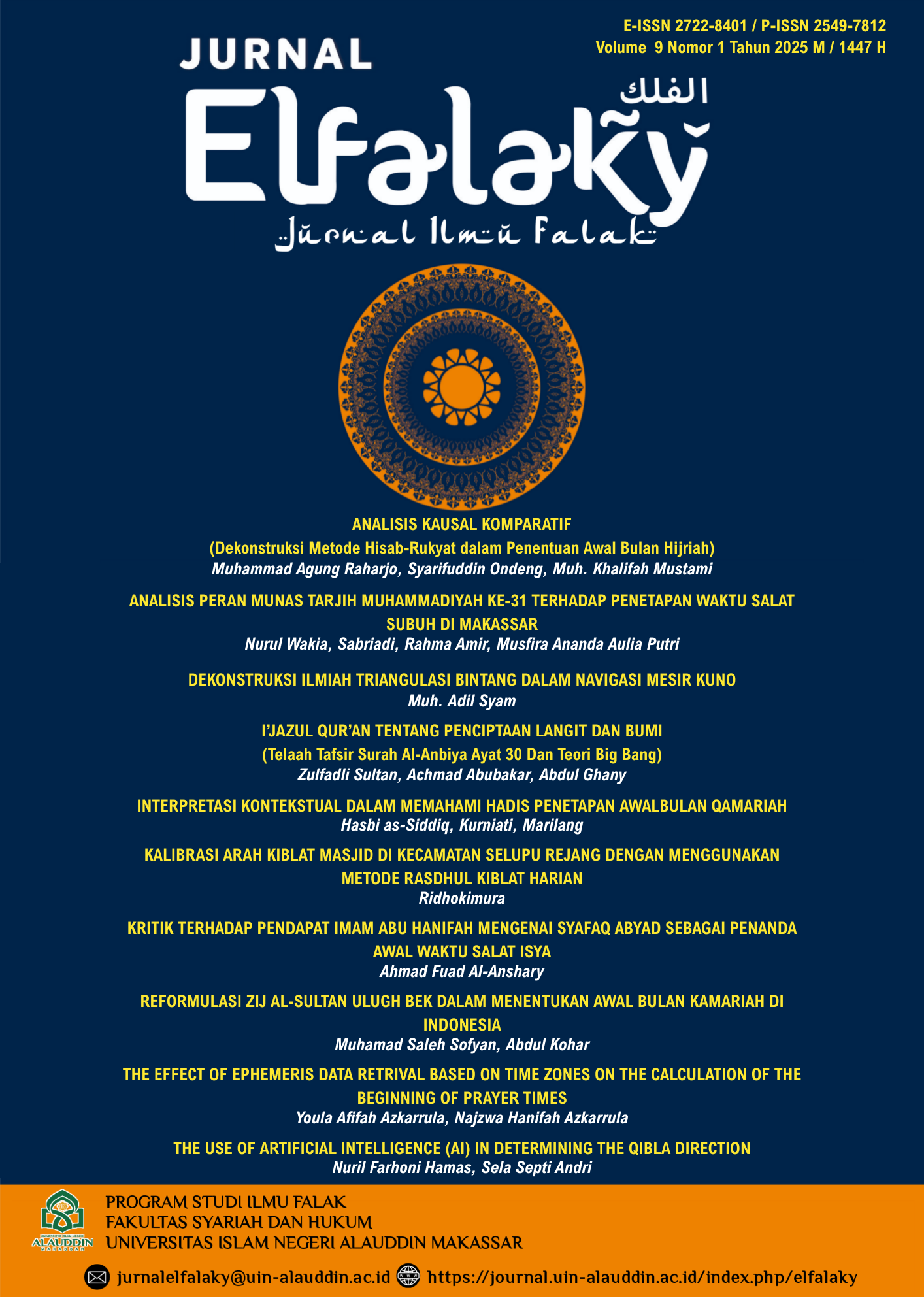ANALISIS PERAN MUNAS TARJIH MUHAMMADIYAH KE-31 TERHADAP PENETAPAN WAKTU SALAT SUBUH DI MAKASSAR
DOI:
https://doi.org/10.24252/ifk.v9i1.58067Keywords:
Dawn Time, Muhammadiyah Tarjih National Conference, Public Response.Abstract
This study examines the role of the 31st Muhammadiyah Tarjih National Conference on the determination of the dawn prayer time in Makassar, where there is no uniformity in the application of the dawn time, especially related to the adjustment of the time based on the decision of the 31st Muhammadiyah Tarjih National Conference. The focus of this study is to identify the public response and the method of determining the law used by the Tarjih National Conference in determining the criteria for the dawn prayer time. This study is a field research with a qualitative descriptive type and uses a sharia and historical approach. Data were collected through interviews, observations and literature studies, then analyzed using data reduction techniques, data presentation and drawing conclusions. The results of the study indicate that the determination of the initial time for the dawn prayer in Muhammadiyah mosques in Makassar follows the schedule of the Indonesian Ministry of Religion, but for dawn it refers to the decision of the 31st Muhammadiyah Tarjih National Conference with an additional 8 minutes. The public response, both from Muhammadiyah and NU, was generally positive as a form of caution. The implications of this study indicate that the lack of socialization about the change in the beginning of the dawn prayer time in society has resulted in differences among Islamic mass organizations. The community also needs to maintain unity, tolerance, and Islamic brotherhood in responding to differences in ijtihadiyah.
References
Agus Hasan Bashoru, Waktu Subuh Secara Syar'l Astronomis Dan Empiris (Malang: Yayasan Bina Al-Mujtama, 2021), h. 3.
Alex Sobur, Psikologi Umum, (Bandung: Pustaka Setia, 2003), h. 445.
Ali Sodik Sandu Siyoto, Dasar Metodologi Penelitian (Yogyakarta: Media Publishing, 2015), h. 77.
Anggaran dasar dan Anggaran Rumah Tangga Muhammadiyah Bab VI Pimpinan (Pasal 13 Pimpinan Daerah, 2023), h. 4.
Dedy Mulyana, Metodologi Penelitian Kualitatif (Paradigma Baru Ilmu Komunikasi dan Ilmu Sosial Lainnya), Bandung: Remaja Rosdakarya, (2004), h. 160.
Muhammad Hadi Bashori, Pengantar Ilmu Falak (Jakarta: Pustaka Al-Kautsar, 2015), h. 146.
Sugiono, Metode Penelitian Pendidikan, Pendekatan Kuantitatif, Kualitatif, penelitian dan pengembangan, (2011), h. 319.
Jurnal
Eko Atmanto Nugroho, “Relevansi Konsep Fajar dan Senja dalam Kitab Al-qanun Al-masudi bagi Penetapan Waktu Isya dan Subuh”. Jurnal analisis Vol.19 No.1 (2012), h. 95-105.
Herdiwijaya Dhani, “Waktu Subuh; Tinjauan Pengamatan Astronomi”, Jurnal Tarjih, Vol.14 No.1 (2017), h. 51-64.
Khalifah Nur, Amir Rahma, dkk, “Eksistensi Ilmu Falak Penentuan Arah Kiblat dan Awal Waktu Salat”, HISABUNA: Jurnal Ilmu Falak, Vol.2 No.1 (2021), h. 37.
Khalija St., Rasywan Syarif Muh., “Perbandingan Penentuan Awal Waktu Sholat Dengan Metode Hisab Trigonometri dan Program Accurate Tmes Muhammad Odeh”, HISABUNA: Jurnal Ilmu Falak, Vol.2, No.3 (2021), h. 88.
Majelis Tarjih dan Tajdid Pimpinan Pusat Muhammadiyah, Adabul Mar’ah fil Islam (Yogyakarta: Penerbit Muhammadiyah, 2012), h. 74-77.
Muhammad Akmal Andi, dkk, “Perspektif Thomas DjamaluddinTerhadap Eksistensi Fajar Shadiq Dalam Penentuan Waktu Subuh”, HISABUNA: Jurnal Ilmu Falak, Vol.3 No.1, (2022), h. 153.
Nurlaelah, Alimuddin, dkk, “Kriteria Fajar Shadiq Perspektif Ilmu Falak”, HISABUNA: Jurnal Ilmu Falak, Vol.4, No.2 (2022), h. 88.
Risma Cahyani, “Putusan Munas Muhammadiyah Mengenai Koreksi Ketinggian Matahari Subuh dalam Fiqih dan Astronomi”, Al-Syakhsiyyah Journal of Law and Family Studies, Vol. 3 No.1 (2021), h. 83.
Unggul Suryo Adi, “Problematika Awal Waktu Subuh Antara Fiqih Dan Astronomi”, Al-Affaq , Vol.2 No.2 (2020), h. 45.
Utami Dwi, Amir Rahma, dkk, “Pengaruh Peredaran Bumi Terhadap Penentuan Awal Waktu Salat Perspektif Fikih Ibadah dan Astronomi”, HISABUNA: Jurnal Ilmu Falak, Vol.4 No.2 (2023), h. 41.
Wakia Nurul, dkk, “Kriteria Tinggi Matahari dalam Penentuan Awal Waktu Salat Subuh Perspektif Fikih dan Astronomi”, Vol.4 No.3, HISABUNA: Jurnal Ilmu Falak, (2023), h. 51.
Al-Qur’an
Kementerian Agama RI, ‘Al-Qur’an dan Tafsirnya’ (Jakarta: 2022) Lajnah Pentashihan mushaf Al-Qur'an Gedung Bayt Al-Qur`an & Museum Istiqlal, h. 290.
WAWANCARA
Muhammad Yusuf dan Abd. Syukur, Pengurus Masjid Jabal Nur, Wawancara (Makassar: 10 Februari 2025).
Zainal Abidin, Sekretaris Majelis Tarjih dan Tajdid PDM Kota Makassar, Wawancara (Makassar: 6 Februari 2025).
Zul Ishaq Nur, Pengurus Masjid Darul Muttaqin, Wawancara (Makassar: 7 Februari 2025).
Website
Asjumi Abdurrahman, Manhaj Tarjih Muhammadiyah, Diakses pada 17 Maret 2025. https://tarjih.or.id/manhaj-tarjih-muhammadiyah/









